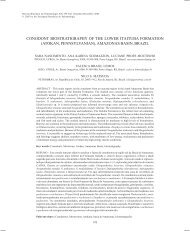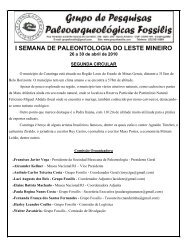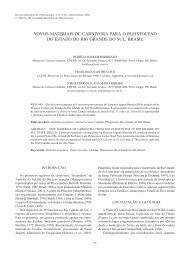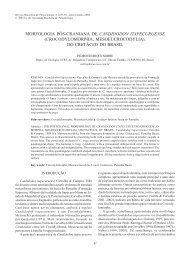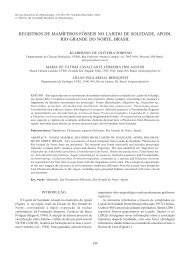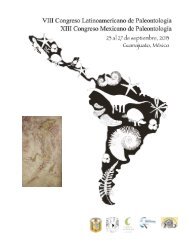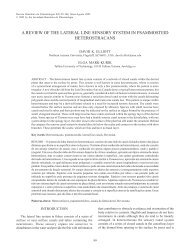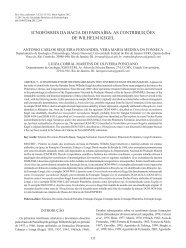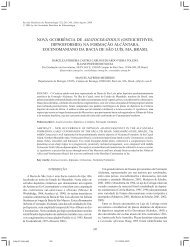new postcranial remains of smilodon populator lund, 1842
new postcranial remains of smilodon populator lund, 1842
new postcranial remains of smilodon populator lund, 1842
Create successful ePaper yourself
Turn your PDF publications into a flip-book with our unique Google optimized e-Paper software.
200<br />
REVISTA BRASILEIRA DE PALEONTOLOGIA,11(3), 2008<br />
Figure 1. Location map <strong>of</strong> Abismo Iguatemi locality, in São Paulo State, Brazil.<br />
accept a specific differentiation between these forms, applying<br />
the name S. fatalis Leidy, 1869, to the North American form,<br />
given its priority over S. californicus Bovard, 1907. More<br />
recently, S. gracilis Cope, 1880 was acknowledged as a third<br />
and more basal taxon, restricted to the Late Pliocene-Middle<br />
Pleistocene <strong>of</strong> North America (Kurtén & Werdelin, 1990). This<br />
paper will adopt the scheme proposed by Berta (1985), in<br />
which Smilodon <strong>populator</strong> represents the only South<br />
American saber-toothed cat. In any case, even in the threespecies<br />
scheme proposed by Kurtén & Werdelin (1990), all<br />
the cis-Andean Smilodon forms (including the Brazilian ones)<br />
are referred to S. <strong>populator</strong>. The nomenclatural status <strong>of</strong> S.<br />
<strong>populator</strong> is also questionable (see Burmeister, 1866; Lund,<br />
1950; Churcher, 1967), given the possible priority <strong>of</strong> other<br />
specific names such as “Hyaena” neogaea Lund, 1839 and<br />
“Felis” protopanther Lund, 1839. Yet, we will follow the<br />
orthodoxy (Paula-Couto, 1979; Berta, 1985; Kurtén &<br />
Werdelin, 1990) and refer the Brazilian saber-toothed cat to S.<br />
<strong>populator</strong>.<br />
The fossils described here have been collected in the 44<br />
m in plan and 15 m deep karstic fissure known as Abismo<br />
Iguatemi (Figure 1). This was formed in the intensively folded<br />
rocks <strong>of</strong> the Açungui Group (Middle Proterozoic) that includes<br />
metamorphized dolomitic limestones intercalated with<br />
insoluble lithologies (Auler & Farrant, 1996). The fissure was<br />
initially explored by Ferreira & Karmann (2002), who named<br />
the site and retrieved paleontological material, including a<br />
skull and both mandibular rami possibly associated with the<br />
specimens described herein. This skull presents prominent<br />
post-orbital process, long post-canine diastema, and absence<br />
<strong>of</strong> the second premolar teeth (Hingst-Zaher et al., 2003). The<br />
cave deposits are mainly composed <strong>of</strong> a black to reddish clay<br />
associated with larger clasts <strong>of</strong> limestone, filite and calcite<br />
crusts. Concerning the age <strong>of</strong> this material, recent C 14 AMS<br />
(Accelerator Mass Spectrometry) dates <strong>of</strong> Smilodon<br />
<strong>populator</strong> were given as 14,580 years BP (Alex Hubbe; verbal<br />
comm. 30/05/2008).<br />
MATERIAL AND METHODS<br />
The skeletal <strong>remains</strong> described here were collected by<br />
members <strong>of</strong> the Museu de Zoologia <strong>of</strong> the Universidade de<br />
São Paulo and are deposited at the fossil collection (MZSP)<br />
<strong>of</strong> that institution. Given the rarity <strong>of</strong> comprehensive<br />
osteological descriptions <strong>of</strong> Brazilian saber-toothed cats<br />
(Cartelle & Abuhid, 1989), the main reference adopted for<br />
anatomical nomenclature and measurements was the study<br />
<strong>of</strong> Merriam & Stock (1932) on S. fatalis from Rancho La Brea,<br />
with complementary data from Cartelle & Abuhid (1989) and<br />
Rodrigues et al. (2004). For anatomical terminology, Nomina<br />
Anatomica Veterinaria (ICVGAN, 2005) was followed<br />
whenever possible.<br />
PROVAS<br />
SYSTEMATIC PALEONTOLOGY<br />
CARNIVORA Bowdich, 1821<br />
FELIDAE Fischer, 1817<br />
MACHAIRODONTINAE Gill, 1872<br />
Smilodon <strong>populator</strong> Lund, <strong>1842</strong><br />
(Figures 2-5, Tables 1-3)<br />
Specific assignation. The diagnosis <strong>of</strong> S. <strong>populator</strong> (Paula-<br />
Couto, 1955; Berta, 1985; Kurtén & Werdelin, 1990) includes<br />
characters that can not be observed in the specimens <strong>of</strong><br />
Abismo Iguatemi. However, the possibly associated skull<br />
falls into the morphometric range <strong>of</strong> that taxon (Hingst-Zaher<br />
et al., 2003). Additionally, Paula-Couto (1955) stated that the<br />
South American saber-toothed cats usually have longer and<br />
stouter long bones than those <strong>of</strong> North America, a condition<br />
observed in the material described here.<br />
Material. MZSP-PV 07, 08, thoracic vertebrae; MZSP-PV 09-<br />
14, 16, 18, 19, 21, ribs; MZSP-PV 05, right ulna; MZSP-PV 04<br />
left radius; MZSP-PV 02,03 left and right innominates; MZSP-<br />
PV 01, left femur; MZSP-PV 06, right astragalus. MZSP-PV<br />
15, 17, 20, anatomically indeterminate elements that may not



